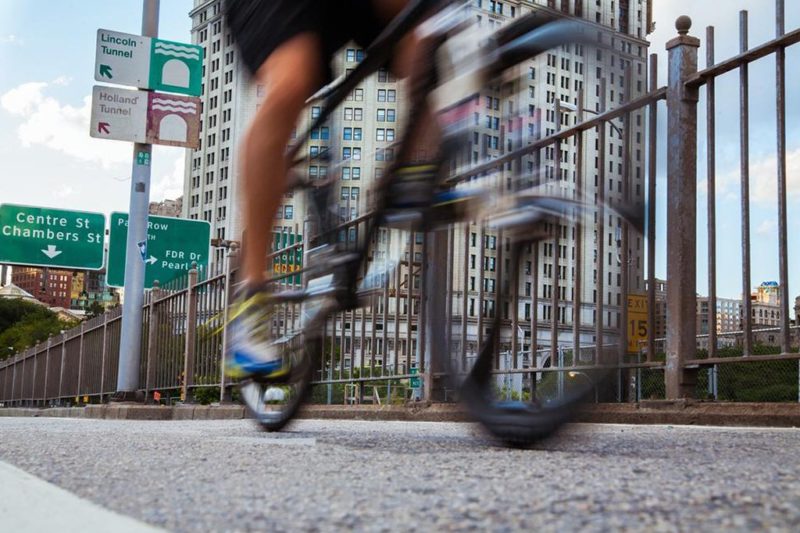- View Larger Image

Why should communities across the country embrace initiatives focused on increasing biking and walking? As it turns out, riding a bike and walking have demonstrated a wide range of benefits. Embracing biking and walking campaigns can bolster personal health, help American communities thrive, and protect the environment.
Advocacy campaigns for bicycling and walking should be able to relay these benefits to towns and communities across the United States. These benefits can help to encourage biking and walking programs in America.
Personal Health Benefits
Exercise is great for personal health. Trading in your car for a bicycle or pair of walking shoes is a simple way to increase the amount of exercise you get.
You’re Less Likely to Die Early
Bicyclists are less prone to dying early than those individuals who do not ride, at all. At least one study found that spending one hour a day on a bike can reduce your risk of death by 18 percent. Adding an extra half an hour to your routine can drop your risk of death by nearly 28 percent.
What about walking? Simply choosing to add in some extra steps during your day can also lower your risk of death. One study found that walking can reduce the risk of death by 39 percent.
Lower Risk of Heart Disease & Stroke
Bicyclists have healthy hearts. In fact, cyclists tend to have an 18 percent lower rate of heart disease than people who do not ride. Choosing to walk can also reduce the chances of suffering from cardiovascular issues. Studies have shown that walking every day can significantly reduce the chances of having a stroke.
Reduced Risk of Cancer
Did you know that riding a bike may reduce your chances of developing cancer? A 2012 Chinese study found that increased cycling is positively correlated with reduced reports of colon cancer. In fact, cyclists in the study experienced “45 percent fewer incidences of cancer” than people who did not ride a bicycle.
Fighting the Diabetes Epidemic
Type II Diabetes is increasingly problematic in the United States. The disease is often the result of a perfect storm: poor dietary choices and a lack of exercise. Ditching the car to bike or walk to work is a simple way to reduce the chances of being affected by diabetes. One European study found that people who bike for at least 30 minutes a day are 40 percent less likely to develop the disease.
Increased Mental Health
Biking and walking are not only good for the body. Bicycling and walking are also incredibly beneficial for the mind, as well. Studies show that people who choose to bike or walk tend to suffer from depression, anxiety, and other mental health issues less than others. Getting exercise by biking or walking can help to increase blood flow, release endorphins, and reduce overall stress. Even logging 30 minutes of walking a day can help to improve mental health and energy.
Reduced Traffic
As more people choose to bike and walk, roads across the country will become less congested. A Canadian study found that when cities opt to invest in “active transportation,” traffic and congestion decrease significantly.
Benefits of reduced traffic include:
- More reliable travel times
- Reduced delays caused by traffic accidents
- Increased access to city facilities and services, and
- Reduced transportation costs.
Why should your town be interested in reducing local traffic? The best way to get their attention is by telling them it will save money! At least one report found that traffic jams can cost a major city nearly $3.3 billion each year. Cutting traffic can have an extremely beneficial effect on a town’s budget.
Social & Economic Benefits
Cities that have embraced biking and walking campaigns tend to be happy, healthy, educated, and economically stable. Residents in towns where bicycling and walking are popular have the opportunity to connect and engage with like-minded people. Biking and walking help to foster a community spirit and feeling of unity.
Portland, OR is a great example of how a city investing in alternative modes of transportation can thrive. Since the 1980s, Portland has embraced bicycling and walking in the city. It has dedicated millions of dollars to education efforts and making changes to infrastructure for bicyclist and pedestrian safety.
As a result, it is best known for having some of the happiest, healthiest, and most socially-conscious citizens in the country. Portland’s “astonishing economy” is a direct reflection of this. The booming economy is thanks, in part, to the city’s willingness to embrace alternative transportation.
Environmental & Public Health Benefits
The climate is changing, and transportation is a leading cause. In fact, transportation is the leading contributor of greenhouse gases. Cars, trucks, buses, and other fuel-powered vehicles are responsible for 28.5 percent of all greenhouse gas emissions in the United States.
Why are greenhouse gases so bad for the environment? Greenhouse gases help to trap warmer temperature inside of the Earth’s atmosphere. This increases the overall temperature around the globe. Rising temperatures adversely affect crops, agriculture, sea levels, wildlife, and insects and pests. As temperatures continue to rise, America is experiencing more wildfires, more droughts, and increasing public health concerns.
Reducing traffic by choosing to bike or walk can reap incredible environmental benefits. Consider ditching your car and hopping on a bike or walking the next time you need to go somewhere. Simply choosing environmentally-friendly modes of transportation some of the time can be incredibly beneficial.
For more information, see our benchmarking report and more information on past benchmarking reports.
